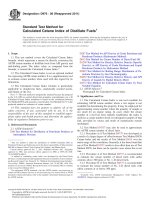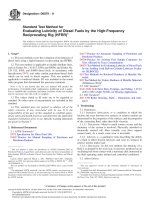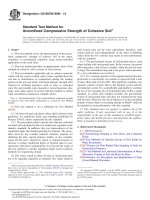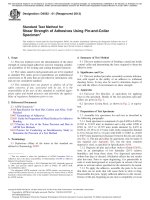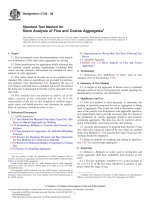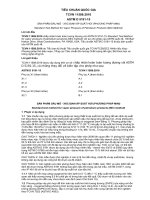ASTM D281-12 (2021) Standard Test Method For Oil Absorption Of Pigments By Spatula RubOut
Bạn đang xem bản rút gọn của tài liệu. Xem và tải ngay bản đầy đủ của tài liệu tại đây (54.87 KB, 2 trang )
This international standard was developed in accordance with internationally recognized principles on standardization established in the Decision on Principles for the
Development of International Standards, Guides and Recommendations issued by the World Trade Organization Technical Barriers to Trade (TBT) Committee.
Designation: D281 − 12 (Reapproved 2021)
Standard Test Method for
Oil Absorption of Pigments by Spatula Rub-out1
This standard is issued under the fixed designation D281; the number immediately following the designation indicates the year of
original adoption or, in the case of revision, the year of last revision. A number in parentheses indicates the year of last reapproval. A
superscript epsilon (´) indicates an editorial change since the last revision or reapproval.
This standard has been approved for use by agencies of the U.S. Department of Defense.
1. Scope when it is used in a pigment paste. Oil absorption values can be
used to characterize pigments or batches of a given pigment.
1.1 This test method covers the determination of the oil
absorption of pigments by the spatula rub-out technique. 4.2 This test method differs from Test Method D1483 in that
D1483 involves only a gentle stirring and folding of the
1.2 The values stated in SI units are to be regarded as pigment, whereas this test method requires a thorough rubbing
standard. The values given in parentheses are for information action. Because the end points are different, the values obtained
only. from the two test methods generally differ.
1.3 This standard does not purport to address all of the 5. Apparatus and Materials
safety concerns, if any, associated with its use. It is the
responsibility of the user of this standard to establish appro- 5.1 Balance, capable of weighing to 0.001 g.
priate safety, health, and environmental practices and deter-
mine the applicability of regulatory limitations prior to use. 5.2 Dropping Bottle, fitted with ground-in pipet and rubber
bulb or buret, graduated in 0.1-mL divisions.
1.4 This international standard was developed in accor-
dance with internationally recognized principles on standard- 5.3 Smooth Glass Rub-up Plate or Marble Slab (glass
ization established in the Decision on Principles for the should have a surface similar to Hoover Muller Plates).
Development of International Standards, Guides and Recom-
mendations issued by the World Trade Organization Technical 5.4 Spatula, sharp-edged, steel, having a blade of 15 or 20
Barriers to Trade (TBT) Committee. mm by 100 mm (1⁄2 or 3⁄4 by 4 in.).
2. Referenced Documents 5.5 Oil, linseed, raw, conforming to the following specifi-
2.1 ASTM Standards:2 cation:
D1483 Test Method for Oil Absorption of Pigments by
Gardner-Coleman Method Specific Gravity 0.926–0.931
Boiling Point >149°C
3. Summary of Test Method Acid Number 3±1
Saponification Value 185–196
3.1 A stiff, putty-like paste is formed by the dropwise Iodine Value 170 minimum
addition of linseed oil to pigment that is being thoroughly Gardner Color
rubbed with a spatula. The amount of oil required to produce 13 maximum
the end point is used to calculate an oil absorption value.
5.5.1 Linseed oil used in comparative tests must have the
4. Significance and Use same acid value. Other liquids, such as refined oil, may be used
by mutual agreement.
4.1 The oil absorption value obtained by this test method
gives information about the vehicle demand of the pigment 6. Procedure
1 This test method is under the jurisdiction of ASTM Committee D01 on Paint 6.1 Procedure A (Weighing Bottle)—Weigh exactly 1 g, or
and Related Coatings, Materials, and Applications and is the direct responsibility of any multiple thereof (Note 1), of the thoroughly mixed and air
Subcommittee D01.24 on Physical Properties of Liquid Paints & Paint Materials. dried pigment and place upon a glass plate or marble slab.
Weigh to 0.01 g a dropping bottle containing raw linseed oil
Current edition approved June 1, 2021. Published June 2021. Originally along with the pipet and rubber bulb. Add the linseed oil
approved in 1928. Last previous edition approved in 2016 as D281 – 12 (2016). gradually, drop by drop (by means of the pipet), to the pigment.
DOI: 10.1520/D0281-12R21. After the addition of each drop, thoroughly incorporate the oil
by rubbing up with the spatula. The test is complete when
2 For referenced ASTM standards, visit the ASTM website, www.astm.org, or exactly enough oil has been incorporated with the pigment to
contact ASTM Customer Service at For Annual Book of ASTM produce a very stiff, putty-like paste, that does not break or
Standards volume information, refer to the standard’s Document Summary page on separate. Weigh the bottle and oil to 0.01 g and determine by
the ASTM website. difference the weight of oil used. The time that it took to run
the test (in minutes) should be noted. Subsequent tests on the
Copyright © ASTM International, 100 Barr Harbor Drive, PO Box C700, West Conshohocken, PA 19428-2959. United States
1
D281 − 12 (2021)
same kind of pigment should be performed in approximately 8. Report
the same period of time. Any device capable of measuring
minutes may be used. 8.1 Report the oil absorption of the pigment as the number
of grams (pounds) of oil required to exactly wet 100 grams
NOTE 1—The specimen weight depends upon the specific gravity, (pounds) of pigment.
fineness, and other characteristics of the pigment. For example, 20 g is
taken for white lead, but about 1 g is sufficient for carbon black. In any 8.2 Report the time taken to run the test.
event, the specimen size should be large enough so that at least 1 g of oil
is required. 9. Precision and Bias
6.2 Procedure B (Buret): 9.1 On the basis of an interlaboratory study of this test
6.2.1 Follow Procedure A, except add the linseed oil from a method in which one operator in each of five laboratories tested
buret rather than a dropping bottle pipet. Calculate the weight two grades of zinc oxide covering a small oil absorption range
of oil in grams by multiplying the volume oil used by its by spatula rub-out, the within-laboratory coefficient of varia-
density (0.93 g/mL). tion was found to be 4.6 % at 10 df and the between-
laboratories coefficient of variation 11.6 % at 8 df. Based on
6.3 It is suggested that when a new pigment is to be tested, these coefficients, the following criteria should be used for
a preliminary rub-out be made to determine an approximate judging the precision of results at the 95 % confidence level:
end point. Once this is established, the actual determination
should be made with a slower addition of oil and a more 9.1.1 Repeatability—Two results obtained by a single op-
vigorous rub-out through the critical region, therefore permit- erator should be suspect if they differ by more than 14.3 %
ting a more precise assessment of the correct oil absorption end relative.
point.
9.1.2 Reproducibility—Two results obtained by operators in
7. Calculation different laboratories should be considered suspect if they
differ by more than 38.0 % relative.
7.1 From the weights of oil and pigment used in the test,
calculate the number of grams (pounds) of oil required to 9.2 Bias—Since there is no accepted reference material
exactly wet grams of oil per 100 grams of pigment or 100 suitable for determining bias for the procedure in this test
pounds of pigment. method, bias cannot be determined.
10. Keywords
10.1 oil absorption; pigments (general properties); spatula
rub-out test
ASTM International takes no position respecting the validity of any patent rights asserted in connection with any item mentioned
in this standard. Users of this standard are expressly advised that determination of the validity of any such patent rights, and the risk
of infringement of such rights, are entirely their own responsibility.
This standard is subject to revision at any time by the responsible technical committee and must be reviewed every five years and
if not revised, either reapproved or withdrawn. Your comments are invited either for revision of this standard or for additional standards
and should be addressed to ASTM International Headquarters. Your comments will receive careful consideration at a meeting of the
responsible technical committee, which you may attend. If you feel that your comments have not received a fair hearing you should
make your views known to the ASTM Committee on Standards, at the address shown below.
This standard is copyrighted by ASTM International, 100 Barr Harbor Drive, PO Box C700, West Conshohocken, PA 19428-2959,
United States. Individual reprints (single or multiple copies) of this standard may be obtained by contacting ASTM at the above
address or at 610-832-9585 (phone), 610-832-9555 (fax), or (e-mail); or through the ASTM website
(www.astm.org). Permission rights to photocopy the standard may also be secured from the Copyright Clearance Center, 222
Rosewood Drive, Danvers, MA 01923, Tel: (978) 646-2600; />
2
![Standard Test Method for Compressive Strength of Hydraulic Cement Mortars (Using 2-in. or [50-mm] Cube Specimens)](https://media.store123doc.com/images/document/14/rc/yi/medium_yil1395845738.jpg)

